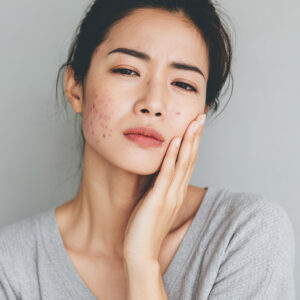Medical coding for acne treatment can feel like navigating a maze, especially when you’re trying to ensure proper reimbursement while providing the best care for your patients. Having the working knowledge of which CPT codes apply to various acne treatments is essential for dermatology practices, family medicine physicians, and healthcare billing professionals who regularly encounter acne cases.
Acne affects millions of people across different age groups, and treatment approaches range from simple office visits to complex surgical procedures. Each treatment modality requires specific coding to accurately represent the services provided and ensure appropriate compensation from insurance carriers.
Office Visit and Evaluation Codes
The foundation of acne treatment coding begins with evaluation and management (E&M) codes. These codes capture the clinical assessment, diagnosis, and treatment planning that occurs during patient encounters. For established patients with acne, you’ll typically use codes 99212 through 99215, depending on the complexity of the visit and medical decision-making involved.

- Code 99212 – Covers straightforward acne cases where minimal examination and simple treatment adjustments occur. This might include patients with mild acne who are responding well to current treatments and need only basic monitoring.
- Code 99213 – applies when moderate complexity is involved, such as evaluating treatment response, adjusting medications, or addressing new acne lesions in different areas.
- Codes 99214, 99215 – More complex cases warrant these codes. These situations might involve severe cystic acne, patients with multiple treatment failures, those experiencing significant side effects from medications, or cases requiring coordination with other specialists. The documentation must support the level of complexity claimed.
- Codes 99202, 99205 – New patient visits use codes 99202 through 99205, with similar complexity considerations but typically requiring more extensive history-taking and examination since this is the initial encounter with the patient.
Acne Comedone Extractions Coding and Procedures
Acne comedone extractions represent one of the most common procedural treatments in dermatology practices.
Primary Procedure Code
- Code 10040 – Covers acne surgery for up to 20 comedones, including both open comedones (blackheads) and closed comedones (whiteheads) that are manually extracted using specialized tools
Additional Codes for Complex Cases
- Code 10060 – Used for incision and drainage of simple abscesses, including larger acne cysts requiring more aggressive intervention
- Code 10061 – Applies to complex or multiple abscesses
Documentation Requirements
- Number of lesions treated must be carefully documented
- Techniques used should be recorded in detail
- Procedures must be medically necessary (not purely cosmetic) to ensure proper reimbursement
Patient Qualifications
- Patients with inflammatory acne that hasn’t responded adequately to topical treatments
- Patients with inflammatory acne that hasn’t responded adequately to oral treatments
- Cases where comedone extraction is deemed medically necessary
Background Information
- Acne comedone extractions are one of the most common procedural treatments in dermatology practices
- Procedures involve manual extraction using specialized dermatological tools
Intralesional Injection Coding for Acne Treatment
Intralesional corticosteroid injections have become a standard treatment for inflammatory acne lesions, particularly cystic acne.

Injection Procedure Codes
- Code 11900 – Covers intralesional injections of up to seven lesions during a single session
- Code 11901 – Applies when injecting more than seven lesions in a single session
Treatment Benefits
- Helps reduce inflammation quickly
- Can prevent scarring from severe acne lesions
- Effective for severe inflammatory acne lesions
Billing Considerations
- Codes address the injection procedure itself only
- Medication cost is billed separately using appropriate J-code for the specific corticosteroid used
- Procedure and medication costs are coded independently
Documentation Requirements
- Specify the number of lesions injected
- Record the medication used
- Document the dosage administered
- Include medical necessity justification
Supporting Documentation
- Photos can be helpful in supporting medical necessity
- Visual documentation particularly valuable for severe cases
- Documentation supports cases that might require multiple treatment sessions
Treatment Applications
- Best suited for severe inflammatory acne lesions
- May require multiple sessions for optimal results
- Targeted approach for specific problematic lesions
Chemical Peel Coding for Acne Treatment
Chemical peels serve as an effective treatment option for acne and acne scarring. The coding depends on the depth and extent of the peel performed.
Procedure Codes
- Code 15788 – Chemical peels of the facial area
- Code 15789 – Chemical peels performed on areas other than the face (such as back or chest where acne commonly occurs)
Light Chemical Peel Types
- Glycolic acid peels – commonly performed for acne treatment
- Salicylic acid peels – commonly performed for acne treatment
Treatment Benefits
- Help unclog pores
- Reduce bacterial colonization
- Improve overall skin texture
Treatment Considerations
- Frequency of treatments varies based on patient response
- Frequency of treatments varies based on severity of acne involvement
- Medium-depth peels may be considered for patients with both active acne and significant scarring
Documentation Requirements
- Coding remains the same regardless of peel depth
- Documentation should clearly indicate medical necessity
- Documentation should include expected outcomes from treatment
Light and Laser Therapy Coding for Acne Treatment
Photodynamic therapy (PDT) has gained popularity as an effective acne treatment, particularly for patients with moderate to severe inflammatory acne.
Photodynamic Therapy
- Code 96567 – Covers photodynamic therapy by external application of light to destroy premalignant lesions
- May require careful documentation of medical necessity when used for acne treatment
Blue Light Therapy
- Often performed without photosensitizing agents
- May be coded under unlisted procedure codes depending on specific device and treatment protocol
- Code 96999 – Used by many practices for unlisted special dermatological procedures when treating acne with light-based therapies that don’t fit standard CPT categories
Laser Treatments for Acne and Scarring
- Require specific coding based on type of laser used
- Require specific coding based on area treated
- Often target both active acne and resulting scarring
Fractional Laser Resurfacing Codes
- Code 15786 – Used for small treatment areas
- Code 15787 – Used for larger treatment areas
General Coding Considerations
- Light-based therapies may not fit into standard CPT categories
- Documentation requirements vary depending on specific treatment protocol
- Code selection depends on device type and treatment approach
Microneedling and Dermabrasion Coding for Acne Treatment
Microneedling has become increasingly popular for acne scar treatment and overall skin improvement.

Microneedling Coding Options
- No specific CPT code exists for microneedling procedures
- Code 15786 – Used by many providers for ablative skin resurfacing when treatment depth and medical necessity support this coding choice
- Code 17999 – Unlisted procedure for skin, mucous membrane and subcutaneous tissue, used by some practices when performing microneedling for acne treatment
Microneedling Coding Requirements
- Maintain consistent coding practices across treatments
- Provide proper documentation of medical necessity
- Ensure treatment depth supports chosen code when using 15786
Dermabrasion Codes
- Code 15780 – Covers dermabrasion of the total face
- Code 15781 – Applies to segmental dermabrasion
- Less commonly used for acne treatment in current practice
Dermabrasion Treatment Applications
- Typically reserved for significant acne scarring rather than active acne treatment
- More aggressive procedure compared to other resurfacing options
General Coding Principles
- Consistency in coding practices is essential
- Documentation must support medical necessity for all procedures
- Code selection should match the actual procedure performed and treatment depth achieved
Cryotherapy Coding for Acne Treatment
Liquid nitrogen treatment for acne lesions falls under cryotherapy codes.
Destruction of Benign Lesions Codes
- Code 17110 – Covers destruction of benign lesions other than skin tags or cutaneous vascular proliferative lesions, including up to 14 lesions
- Code 17111 – Applies to treatment of 15 or more lesions
Effective Treatment Applications
- Inflamed papules that haven’t responded to other treatments
- Pustules that haven’t responded to other treatments
- Certain types of acne lesions that are suitable for cryotherapy intervention
Documentation Requirements
- Procedure must be documented as medically necessary rather than cosmetic
- Proper documentation ensures appropriate reimbursement
- Medical necessity must be clearly established in patient records
Treatment Considerations
- Cryotherapy effectiveness varies based on acne lesion type
- Best suited for specific types of inflammatory acne lesions
- Should be considered when other treatment methods have been unsuccessful
Documentation Requirements
Proper documentation plays a crucial role in successful acne treatment coding. Each encounter should include detailed descriptions of acne severity, distribution, previous treatment response, and current treatment plans. Photos can provide valuable documentation, particularly for more severe cases or when performing procedures.
Treatment notes should specify the medical necessity for any procedures performed. Simple statements about cosmetic improvement aren’t sufficient for insurance reimbursement. Instead, document functional impairment, infection risk, or failure of conservative treatments to justify more aggressive interventions.
For surgical procedures, document the number of lesions treated, specific techniques used, and patient response to treatment. This information supports the complexity level billed and helps justify the medical necessity of the procedures performed.
Common Coding Challenges
One frequent challenge involves determining when acne treatment becomes cosmetic versus medical. Insurance carriers typically cover treatment for moderate to severe acne that causes functional impairment or poses infection risks. Mild acne treatment for purely cosmetic purposes may not qualify for coverage.
Another challenge arises when combining multiple procedures during a single visit. Modifier usage becomes important to indicate when separate procedures are performed. Modifier 59 might be necessary when performing distinct procedures that don’t normally occur together.
Time-based coding can be problematic for acne procedures since many treatments are quick to perform but require significant skill and judgment. Focus on the complexity of medical decision-making rather than just the time spent with the patient.
Summary: Acne Treatment CPT Codes
![]() Staying current with coding updates and payer policies helps avoid claim denials and ensures appropriate reimbursement for acne treatment services. Regular training for clinical and billing staff prevents coding errors that can impact practice revenue and patient satisfaction.
Staying current with coding updates and payer policies helps avoid claim denials and ensures appropriate reimbursement for acne treatment services. Regular training for clinical and billing staff prevents coding errors that can impact practice revenue and patient satisfaction.
A professional, working knowledge of CPT codes and their appropriate applications ensures that acne treatment services are properly documented, coded, and reimbursed. This helps practices provide better patient care while maintaining financial stability through accurate coding practices.
Contact us to handle all of your coding and billing needs and/or challenges.

